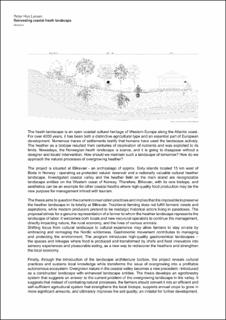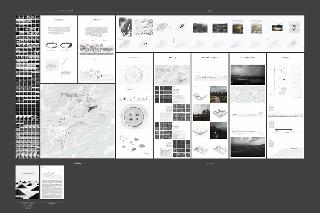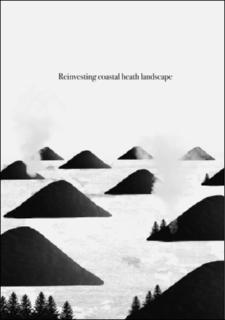| dc.description | The heath landscape is an open coastal cultural heritage of Western Europe along the Atlantic coast. For over 4000 years, it has been both a distinctive agricultural type and an essential part of European development. Numerous traces of settlements testify that humans have used the landscape actively. The heather as a biotope resulted from centuries of deprivation of nutrients and was exploited to its limits. Nowadays, the Norwegian heath landscape is scarce, and it is going to disappear without a designer and locals' intervention. How should we maintain such a landscape of tomorrow? How do we approach the natural processes of overgrowing heather?
The project is situated at Bliksvær - an archipelago of approx. sixty islands located 15 km west of Bodø in Norway - operating as protected natural reservoir and a nationally valuable cultural heather landscape. Investigated coastal valley and the heather field on the main island are recognizable landscape entities on the Western coast of Norway. Therefore, Bliksvær, with its rare biotope, and aesthetics can be an example for other coastal heaths where high-quality food production may be the new purpose for management inlined with tourism.
The thesis aims to question the current conservation practices and implies that it is impossible to preserve the heather landscape in its totality at Bliksvær. Traditional farming does not fulfill farmers’ needs and aspirations, while modern producers pretend to be nostalgic historical actors living in paradoxes. The proposal strives for a genuine representation of a farmer to whom the heather landscape represents the landscape of labor. It welcomes both locals and new neo-rural operators to continue the management, directly impacting nature, the rural economy, and the lives of various animals.
Shifting focus from cultural landscape to cultural experience may allow farmers to stay on-site by embracing and reimaging the Nordic wilderness. Gastronomic movement contributes to managing and protecting the environment. The program introduces high-quality gastronomical landscapes – the spaces and linkages where food is produced and transformed by chefs and food innovators into sensory experiences and pleasurable eating, as a new way to rediscover the heathers and strengthen the local economy.
Finally, through the introduction of the landscape architecture toolbox, the project reveals cultural practices and sustains local knowledge while transforms the issue of overgrowing into a profitable autonomous ecosystem. Overgrown nature in the coastal valley becomes a new precedent - introduced as a constructed landscape with enhanced landscape entities. The thesis develops an agroforestry system that suggests an answer to the current problem of the overgrowing landscape in the valley. It suggests that instead of combating natural processes, the farmers should convert it into an efficient and self-sufficient agricultural system that strengthens the local biotope, supports annual crops to grow in more significant amounts, and ultimately improves the soil quality; an initiator for further development.
In time, landscape architect as an accelerator, the farmer and ecologist can reconstruct intended areas into a new design form, creating social spaces. In between, designed “landscape piazzas” are formed for people to engage with the new, multi-layered landscape. Some of them intend to collect run-off water used for irrigation or animals. They become a destination in the paths of the valley among fertile fields. The surrounding reservoir functions as a unique framework and place to explore.
The project includes facilities where guests may experience the site through their senses. A landscape architect initiates a heather garden where coastal heritage and new gastronomic culture meet. The structures are situated along the main path - a straight line defined by a bedrock uniting the productive valley with the heather garden. The shapes of the proposed architecture resemble turf removal excavation. The work of creating peats has left significant permanent traces in the coastal landscape. As a result of geometrical forms, the proposed architecture is based on the principle of the horizons - earth - infinite - sky horizon. Structures mean implementing local materials and objects on-site into their form, creating a humble, primitive architecture defined as a cave, hut, and platform. In order to increase the interaction between the heather and the encompassing sea, the project provides three additional smaller trails. They unite the heather garden with several sand beaches, which Bliksvær is known for. Travelers in all seasons may access the sea by boats, kayaks, or surfboards. - thus ending in another landscape entity.
The surrounding wild heather and the designed garden are put in contrast to highlight the impact of the traditional practices on nature. The garden becomes a contemporary living museum in its original context merged with the proposed architecture, available for people to interact with, while wild heather is left alone mainly for animals. The garden’s geometrical shapes are temporary, lasting from season to season. The grass functions as a white canvas in time of harvesting in the fall. Farmers and visitors may engage with it and experience the traditional techniques of heather preservation, leaving a temporary imprint in the form of land art. The project suggests two alternatives of the design.
A global shift is needed to ensure enough healthy and safe food for everyone, and at the same time, preserve our heritage. The project focuses on a local scale and reinvests the "forgotten" coast, but it strives to become a guide plan for a new sustainable coastal agricultural system in Norway on a larger scale. The designer's role is to enable these types of landscapes, anticipate climate change and facilitate the locals to shift to more sustainable and innovative farming systems; the urge is to transform these landscapes for more significant food autonomy on the islands and isolated places. Through a design, planning, and management plan, this project can be an answer for this issue; we need designers to help activate these areas. | en_US |


